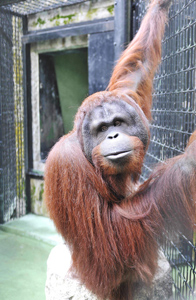
| The Bornean orangutan is an endangered primate. Its large size and lovely appearance have made it the most popular resident of the Hong Kong Zoological and Botanical Gardens. |
Horticulture and Amenities
Hong Kong Zoological and Botanical Gardens
The Hong Kong Zoological and Botanical Gardens provide relief from Hong Kong's urban environment, serving as a 5.6-hectare 'green lung' overlooking the Central District. They also represent a viable conservation centre for 14 endangered mammal, bird and reptile species. The Gardens' bird collection is one of the most comprehensive in Asia, home to about 380 birds of 130 different species, more than 15 of which have reared offspring there. The mammal collection focuses on primates and has 70 exhibits representing 17 species. In early 2010, a 15-year-old male Bornean orangutan named Vandu became the newest inhabitant of the Gardens. Coming to Hong Kong from a zoo in Hungary, Vandu has been paired up with the Gardens' two female orangutans for conservation breeding.
 |
|
||
Trees, shrubs, creepers and foliage of more than 900 plant species thrive in the Gardens. A herb garden was established in 1987, and a greenhouse was built in 1993 to generate specialist interest. These facilities contain about 500 species of herbs, orchids, ferns, bromeliads, and carnivorous and indoor plants. A new education and exhibition centre was completed in 2008 and now provides teaching facilities, guided visits, and displays of botanical and zoological specimens.
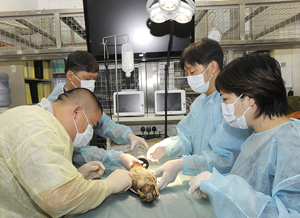 |
|
||
Zoological collections are also housed in Hong Kong Park, Kowloon Park, Tuen Mun Park and Yuen Long Park.
Zoological and Horticultural Education
A number of zoological and horticultural education programmes have been established to arouse public interest in conservation and green issues. Around
22 000 people participated in 425 zoological projects in 2009-10, and more than 22 000 in 433 horticultural programmes. Some 600 education programmes were organised for more than 19 500 students in Hong Kong's schools.
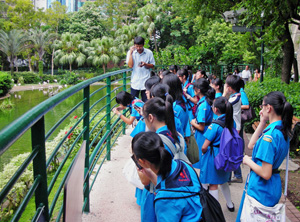 |
|
||
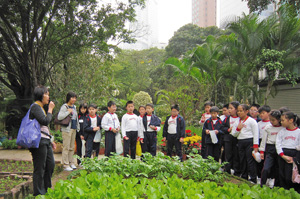 |
|
||
The zoological exhibition at the Hong Kong Zoological and Botanical Gardens attracted about 8 000 visitors during the year, and the horticultural education exhibition at Kowloon Park more than 10 000. Roving exhibitions were also held at Hong Kong Park, Yuen Long Park, Tuen Mun Park, North District Park and Tai Po Waterfront Park, and 12 conservation courses were also offered to enrich the public's knowledge of conservation. These programmes were well-received, as attested by the encouraging feedback received.
The Greening School Subsidy Scheme, which was carried out during the year as part of a school greening programme, provided more than 830 schools and kindergartens with cash subsidies to add more greenery to their campuses and to organise green educational activities for their students, with technical advice provided by part-time instructors. About 350 000 students were given pots of seedlings to nurture at home or at school under the 'One Person, One Flower' Scheme, which was established to provide children with a better understanding of how to grow plants and to encourage them to develop an interest in the subject.
Tree Planting and Preservation
The Department's tree-planting programme continued, with around 4 000 trees planted in 2009-10. Most were planted during the rainy season (March to October) to ensure their establishment and growth.
Seventy per cent of these trees were planted in the New Territories, with the remainder planted in urban areas, including 2 800 along roadsides and 1 200 in parks and gardens.
Trees have traditionally been planted for the functional purposes of providing shade, screening, soil protection and conservation, which has formed a good basis for the greening of the environment. However, aesthetics have also been emphasised in recent years. In 2009-10, for example, about 2 800 flowering trees, including Bauhinia variegata, Delonix regia, Jacaranda mimosifolia, Lagerstroemia speciosa and Spathodea campanulata, were planted to make a greater visual impact and ensure stronger seasonal colours.
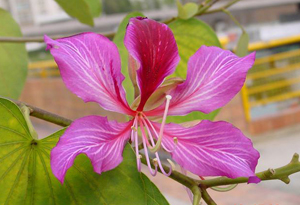 |
|
||
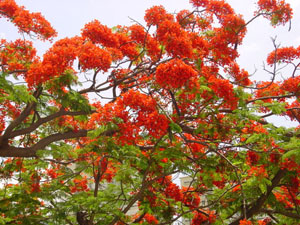 |
|||
Hong Kong's many trees are regularly watered, pruned and fertilised to ensure healthy growth, with weeds removed and pests controlled.
Horticultural and Landscape Services
As the Department is responsible for improving the urban environment and the overall landscape, it collects the latest horticultural and arboricultural information and uses it to update relevant policies and guidelines. The Department also periodically reviews its practices to achieve high-level management and maintenance standards for community amenities.
As part of the greening of Hong Kong, we closely monitor the implementation of planting programmes in all districts, with emphasis placed on preserving existing trees and nurturing new ones, including those planted on development sites. During the year, more than 6 400 trees were successfully preserved.
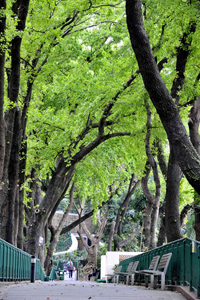 |
|
||
The Department is also responsible for vetting the landscaping of all new public works projects to ensure that maximum planting and high-quality landscape work are provided. In 2009-10, landscape improvements were made on 47 hectares of existing venues, footbridges, vacant government land and roadside amenities.